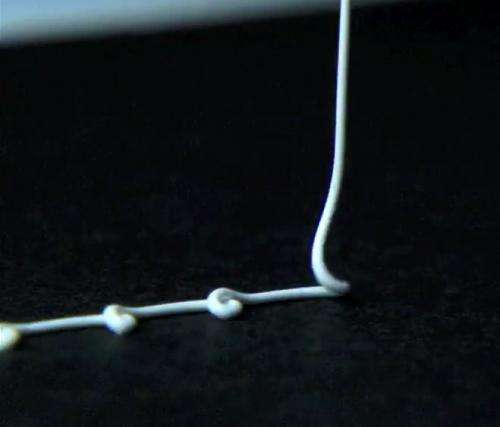The complex fluid dynamics of paint dripping techniques employed by Jackson Pollock

Jackson Pollock, one of the greatest American artists of the 20th century, revolutionized abstract expressionist painting in the mid-20th century with his unique "drip" technique—masterpieces of densely tangled lines of color that Pollock often created from thinned household enamel paints. Now, an experimental technique developed by fluid dynamicists at the Universidad Nacional Autónoma de México in Mexico City may help reveal exactly how Pollock produced certain features in his paintings.
The procedure and some preliminary findings will be described today in a talk at the American Physical Society's Division of Fluid Dynamics (DFD) meeting in San Francisco, Calif.
Created by mechanical engineering professor Roberto Zenit, his undergraduate student Bernardo Palacios and their colleagues, the technique generates paint drippings in a controlled manner. With it, Zenit said, "We can vary the speed and the height at which the paint is ejected onto a horizontal plane," mimicking the unusual technique used by Pollock.
As anyone who has seen the selfsame 2000 biopic starring actor Ed Harris knows, Pollock worked by pouring, dripping, flicking or splattering paint onto, for example, an unstretched canvas laid flat on the floor. Pollock sometimes poured straight from a can of paint, or used sticks or stiffened brushes to drizzle the paint onto the surface.
"In our lab we have the inability to say 'no' to an interesting fluid mechanics problem," Zenit said, "and fluid mechanics can be used to understand painting, since it is essentially a flow problem."
In particular, Zenit, Palacios and their colleagues are interested in how the properties of paints themselves influence artworks such as Pollock's.
Fluids can be either Newtonian or non-Newtonian, depending on whether or not their viscosity (a measure of their resistance to flow) changes in response to an applied stress. In a Newtonian fluid, such as water, the viscosity does not change when the fluid is under more or less stress. However, in a non-Newtonian fluid, the viscosity varies. "For instance," said Zenit, "the viscosity of blood changes if it flows in large or small capillaries. Saliva can go back after it has left the mouth of a child; this characteristic is only possible because it is a little bit elastic."
Paint falls into the latter category: it is what is known as a viscoelastic shear-thinning non-Newtonian fluid. That is, it becomes thinner and flows more freely when stress is applied.
To investigate the importance of such properties in creating drippings like those in Pollock's work, the Zenit lab is using its technique to generate patterns using both Newtonian and non-Newtonian paints, while, for example, keeping the rate of the flow of the paints fixed. "One particular property of viscoelastic fluids is that they oppose a large resistance to being stretched," Zenit said. "Our preliminary results indicate, that, indeed, some of the blobs in the patterns result from this particular property of non-Newtonian fluids, although we still have many more tests to conduct."
"We are planning to extend this type of painting analysis to other artists," he said. "We are currently studying the effect of fluid properties on the pattern created by brush strokes, and we are also looking into hydrodynamic instabilities in water color paintings."
More information: meetings.aps.org/Meeting/DFD14/Session/H1.2
Provided by American Physical Society















.jpg)




